The options dialog is controlled by an options-tree on the left-hand side. Each one of the items on the left brings up a new window on the right.
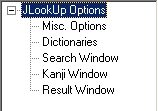
- JLookUp Options
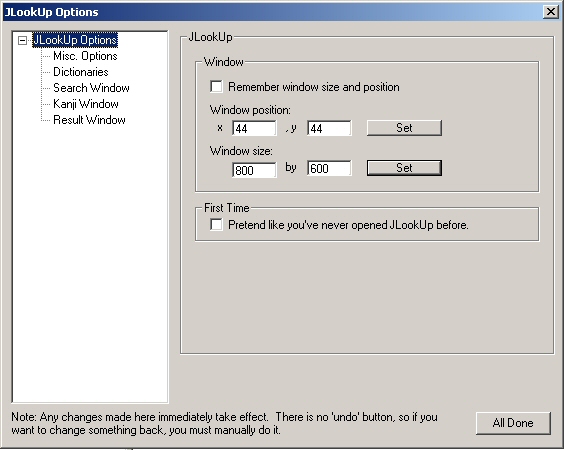
- [x] Remember window size and position
- If this is checked, then JLookUp will start up in exactly the same position as it was when you closed it. This setting also saves the widths and heights of the other windows within the main window.
- Window position
- Originally, this is the window's position. You may manually change it by changing these numbers and pressing 'Set'.
- Window size
- Originally, this is the window's size. You may manually change it by changing these numbers and pressing 'Set'.
- [x] Pretend like you've never opened JLookUp before.
- If this is checked, then it treats both this time and the next time as if they are your first time using JLookUp
- Misc. Options
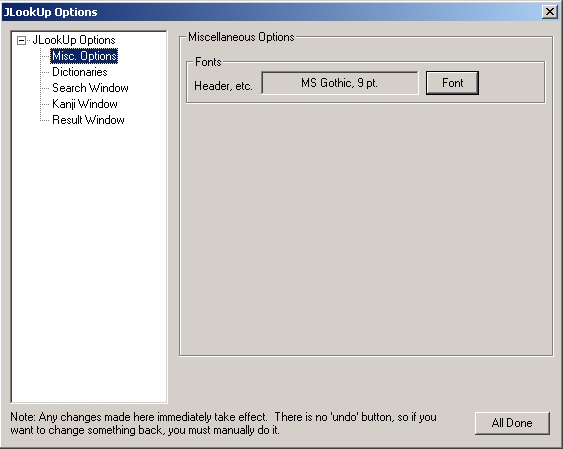
- Header
- Click on Font to change the font. This font applies to just about every font that isn't especially customizable, including the font for the number of results, and the font for the headers in the Kanji and Result Windows.
- Dictionaries
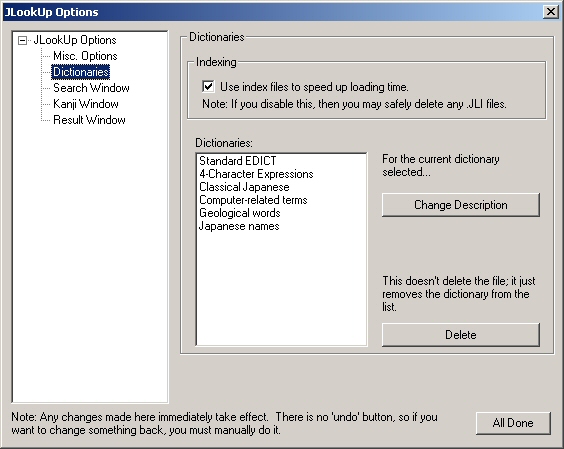
- Use index files to speed up loading time
- JLookUp uses 16-bit Unicode for characters, but EDICTs are in 8-bit EUC encoding. Now, this means that JLookUp has to do some conversions before it can finish loading the dictionaries. And by 'some', I mean 'a lot'. JLookUp makes an index no matter what you say, but it keeps it in memory. If you check this, then it writes the index to a file (the first time). Now, every time it goes to load that dictionary, it will just read in the index (really fast) instead, and save a ton of time.
- Change Description
- When a dictionary is added, it's 'display name' is its filename. That's not really descriptive, so you can change it by clicking on this button.

- Dictionary File
- The dictionary's filename.
- Current Description
- What its current description is.
- New Description
- Here, you may enter a new description for the dictionary.
- Delete
- This does NOT delete the dictionary from your disk. It merely removes it from the program's options so it won't load again.
- Search Window
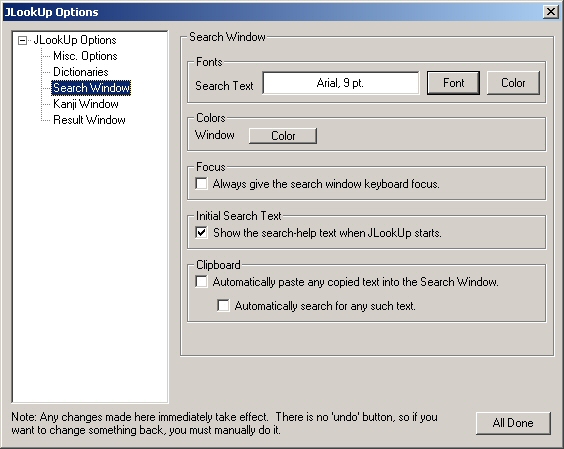
- Search Text
- Click on Font to change the font. This is the font that the Search Window uses.
Click on Color to change the Search Window's font's color. - Window
- Click on Color to change the background color for the Search Window.
- [x] Always give the Search Window keyboard focus.
- No matter what window you move your mouse over, the Search Window gets the keyboard focus.
- [x] Show the search-help text when JLookUp starts.
- This puts the corny search-help text in the Search Window when JLookUp starts.
- [x] Automatically paste any copied text into the Search Window.
- Whenever text is copied, it goes straight to JLookUp.
- [x] Automatically search for any such text.
- Whenever the above action takes place, JLookUp will search for the new text.
- Kanji Window
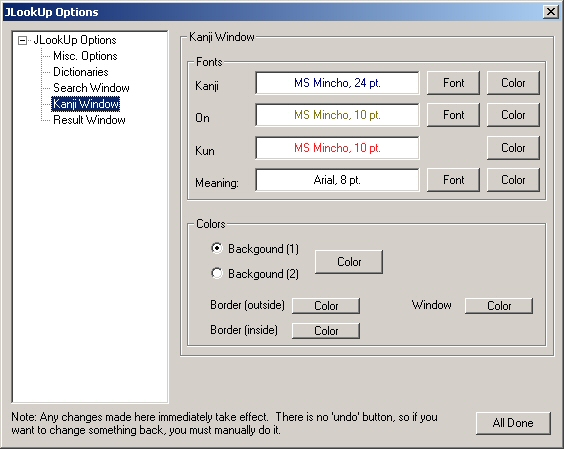
The font-part has the following format:
(preview) [Font] [Color]
- Kanji
- This is the font that the Kanji Window's kanji uses. This should be pretty big (for the kanji).
Click on Font to change its font and size.
Click on Color to change its color.
- On
- This is the font that the Kanji Window's On reading uses.
Click on Font to change its font and size.
Click on Color to change its color.
- Kun
- The Kanji Window's Kun font is the same as the On font. You may only change its color.
Click on Color to change its color.
- Meaning
- This is the font that the Kanji Window uses for any other text (especially the English meanings).
Click on Font to change its font and size.
Click on Color to change its color.
After the fonts, there is the color section.
- Background (1) and (2)
- Entries alternate in background color to make it easier to read. Clicking Background (1) will cause the fonts to preview with that color (and the same for Background (2)).
Click on Color to change the currently selected Background color.
- Border (outside)
- This is the border around an entire entry.
Click on Color to change its color.
- Border (inside)
- This is the little border that separates the parts of an entry.
Click on Color to change its color.
- Window
- This is the window's background color. In other words, if there is no entry at a certain spot, this is the color you see.
Click on Color to change its color.
- Result Window
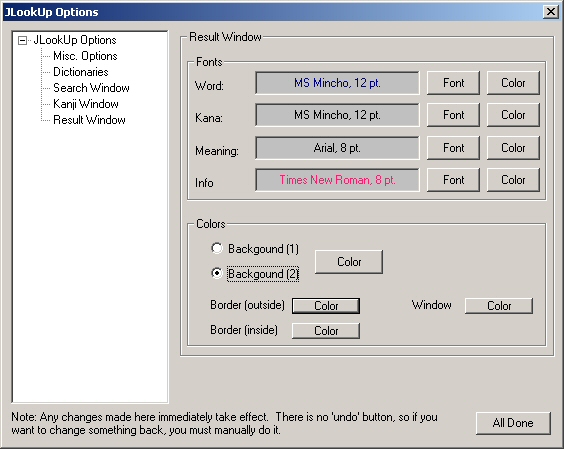
The font-part has the following format:
(preview) [Font] [Color]
- Word
- This is the font that the Result Window's word uses.
Click on Font to change its font and size.
Click on Color to change its color.
- Kana
- This is the font that the Result Window's kana uses.
Click on Font to change its font and size.
Click on Color to change its color.
- Meaning
- This is the font that the Result Window's meanings use. Anything that isn't specifically mentioned as having a font uses this one as well.
Click on Font to change its font and size.
Click on Color to change its color.
- Info
- This is the font that the Result Window uses the extra information about an entry (such as 'noun').
Click on Font to change its font and size.
Click on Color to change its color.
After the fonts, there is the color section.
- Background (1) and (2)
- Entries alternate in background color to make it easier to read. Clicking Background (1) will cause the fonts to preview with that color (and the same for Background (2)).
Click on Color to change the currently selected Background color.
- Border (outside)
- This is the border around an entire entry.
Click on Color to change its color.
- Border (inside)
- This is the little border that separates the parts of an entry.
Click on Color to change its color.
- Window
- This is the window's background color. In other words, if there is no entry at a certain spot, this is the color you see.
Click on Color to change its color.
|
|
|
|
|
|
|
|
|
|
|
|
(Back to Table of Contents)